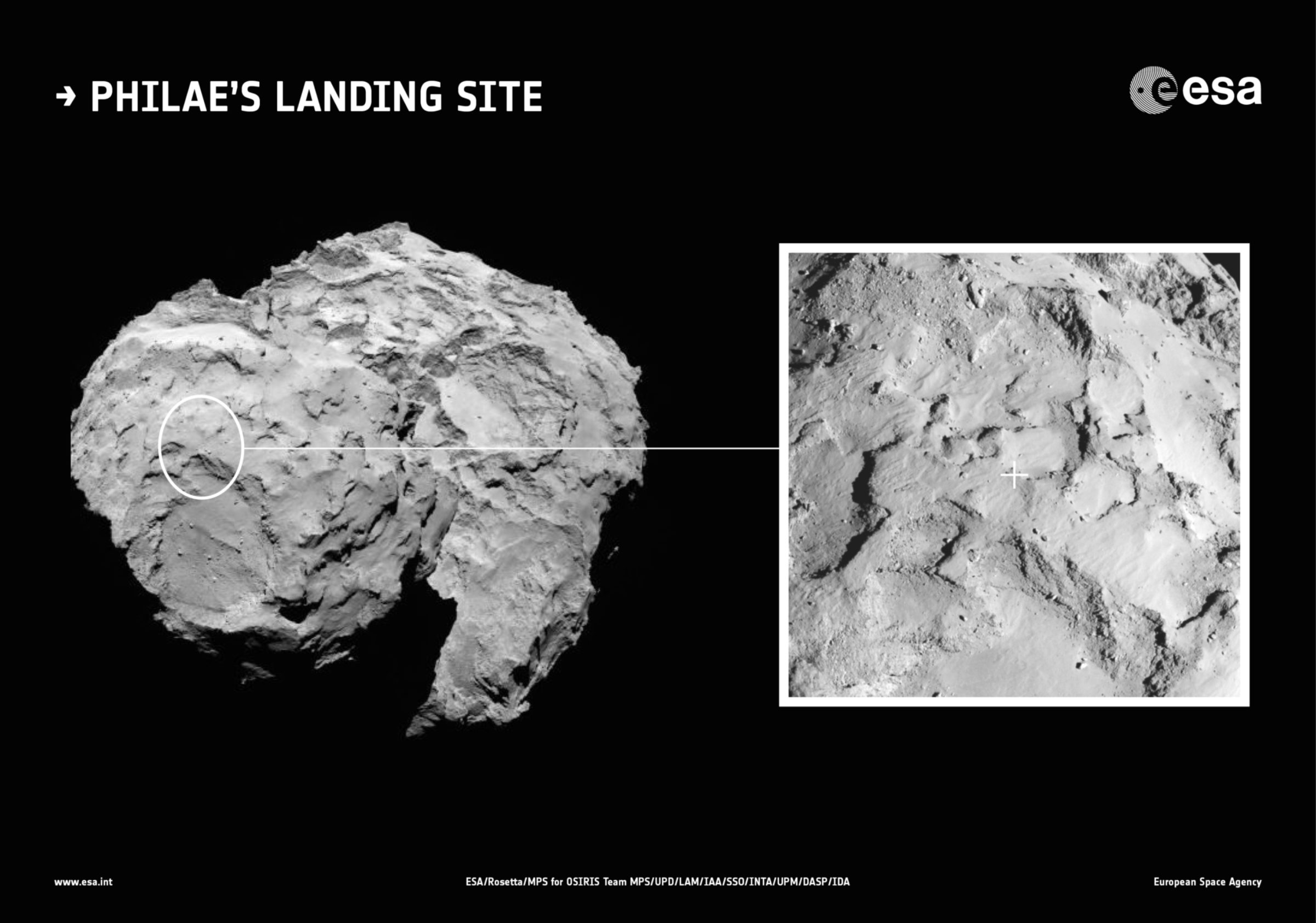Emily Lakdawalla • Sep 15, 2014
A landing site for Philae, but it's not going to be easy
This morning, the European Space Agency announced the selection of a landing site for little Philae on comet Churyumov-Gerasimenko. From the five options announced on August 25, they have downselected to "Site J," located on the top of the head of the capybara-shaped comet:


Although a primary site has been selected, landing Philae successfully is going to be tough, and the mission is now working to manage people's expectations. At the press briefing, Rosetta's project manager Fred Jansen acknowledged that they would have had only a 70 to 75% chance of landing success if the comet were closer to spherical; the distinctly two-lobed shape makes navigating the lander much harder. Just how much harder, Jansen didn't say. In his article for BBC News, Jonathan Amos quoted Jansen as saying only "At the end of the day, you'll only know when you land. Then it will have been either 100% or zero. That's the way it is." They have no control over the trajectory of the lander once it separates from Rosetta; once they release it, it will land wherever gravity takes it. If Philae fails, there will still be fantastic science return from Rosetta. Since my last update, the ESA blog has posted several more stories about science results from different instruments, including dust tracking by GIADA and water vapor, ammonia, and methanol detected by MIRO.
Here's a closer, 3D look at site J (grab your 3D glasses or click on the links below for different ways of seeing the stereo). Amateur image processor Mattias Malmer wasted no time in turning this 3D image into a shape model and even shared this shape model in .obj format -- anybody want to 3D-print their own model of the landing site?

I was interested in seeing the selected site from different angles and under different illumination conditions, so I collected all of the NavCam images where it was clearly visible and very crudely marked the location of that OSIRIS 3D image of the landing site:

Here are crops from each of those images. Each crop is a 2-kilometer square centered on the landing site:
Site J was not exactly the best landing site; it's more accurate to say that, given all the constraints, Site J was the least bad option. In the European Space Agency press release about the landing site selection, Philae project manager Stephan Ulamec stated "The comet is a beautiful but dramatic world – it is scientifically exciting, but its shape makes it operationally challenging....None of the candidate landing sites met all of the operational criteria at the 100% level, but Site J is clearly the best solution."
What made Site J the least bad option? According to an update posted at the CNES website, sites A and I were almost immediately dismissed because they failed to meet many of the safety and science criteria. One thing that made Site J attractive was the relatively low amount of local slopes greater than 30 degrees; with steeper slopes comes a risk of Philae tipping over during landing. Philae would likely be able to do some science if tipped on its side, but none if on its head. Site J also seems to possess fewer large blocks than the other sites. It receives enough sunlight for Philae's battery to stay charged, lengthening the period of time over which it can gather science data from days to weeks, at least in theory. And landing simulations show that the lander will hit the comet at a speed of 0.95 meters per second, which is well within the lander's operational limits.
They also needed to select a backup site for further study, in case something is discovered that suddenly disqualifies site J. A reminder of where the five sites were:

With A and I out of the running, the list was narrowed to B and C. They selected C over B because C had better illumination conditions and lower numbers of potentially hazardous blocks. However, the CONSERT instrument team (which plans to perform radar sounding through the interior of the comet between orbiter and lander) was strongly opposed to site C as an option. The CNES update quotes CONSERT principal investigator Wlodek Kofman as saying "If you go for C, we're out!" However, he later said that their experiment could be conducted at site C if special Rosetta trajectories were designed to accommodate the needs of CONSERT.
For a lot more detail on the landing site selection and the rationale behind it, you can watch the ESA press briefing or read Jonathan Amos' excellent report.
Support our core enterprises
Your support powers our mission to explore worlds, find life, and defend Earth. You make all the difference when you make a gift. Give today!
Donate

 Explore Worlds
Explore Worlds Find Life
Find Life Defend Earth
Defend Earth


